Understanding and Preventing Credit Card Fraud
VerifiedAdded on 2022/10/01
|13
|3388
|453
AI Summary
This report aims to identify credit card frauds and its various variants, its contexts, common offender methodologies and victimization risk factors, especially with the growth of the internet and computer information systems. The report also aims at finding law enforcement and regulatory responses as well as credit card fraud prevention approaches.
Contribute Materials
Your contribution can guide someone’s learning journey. Share your
documents today.
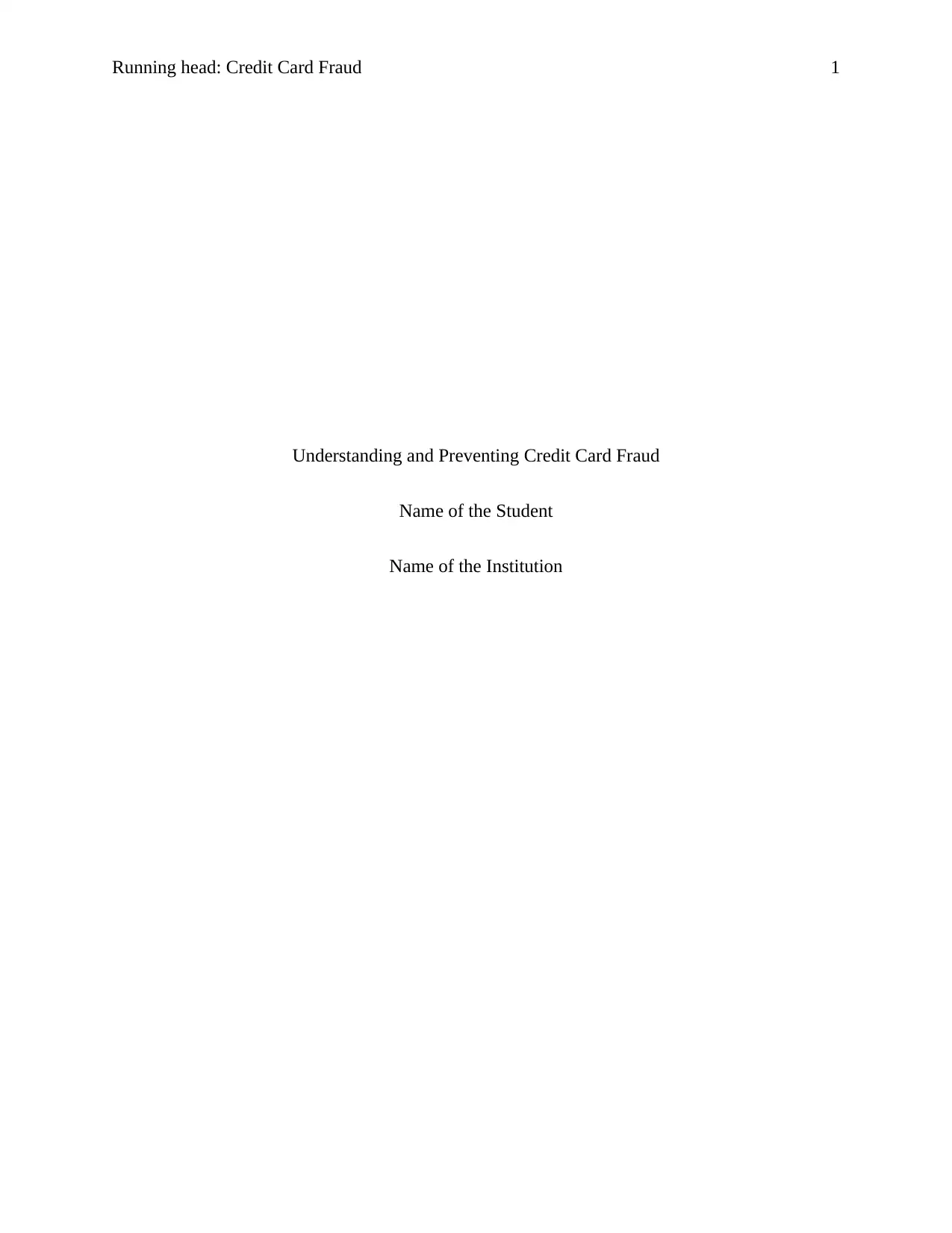
Running head: Credit Card Fraud 1
Understanding and Preventing Credit Card Fraud
Name of the Student
Name of the Institution
Understanding and Preventing Credit Card Fraud
Name of the Student
Name of the Institution
Secure Best Marks with AI Grader
Need help grading? Try our AI Grader for instant feedback on your assignments.
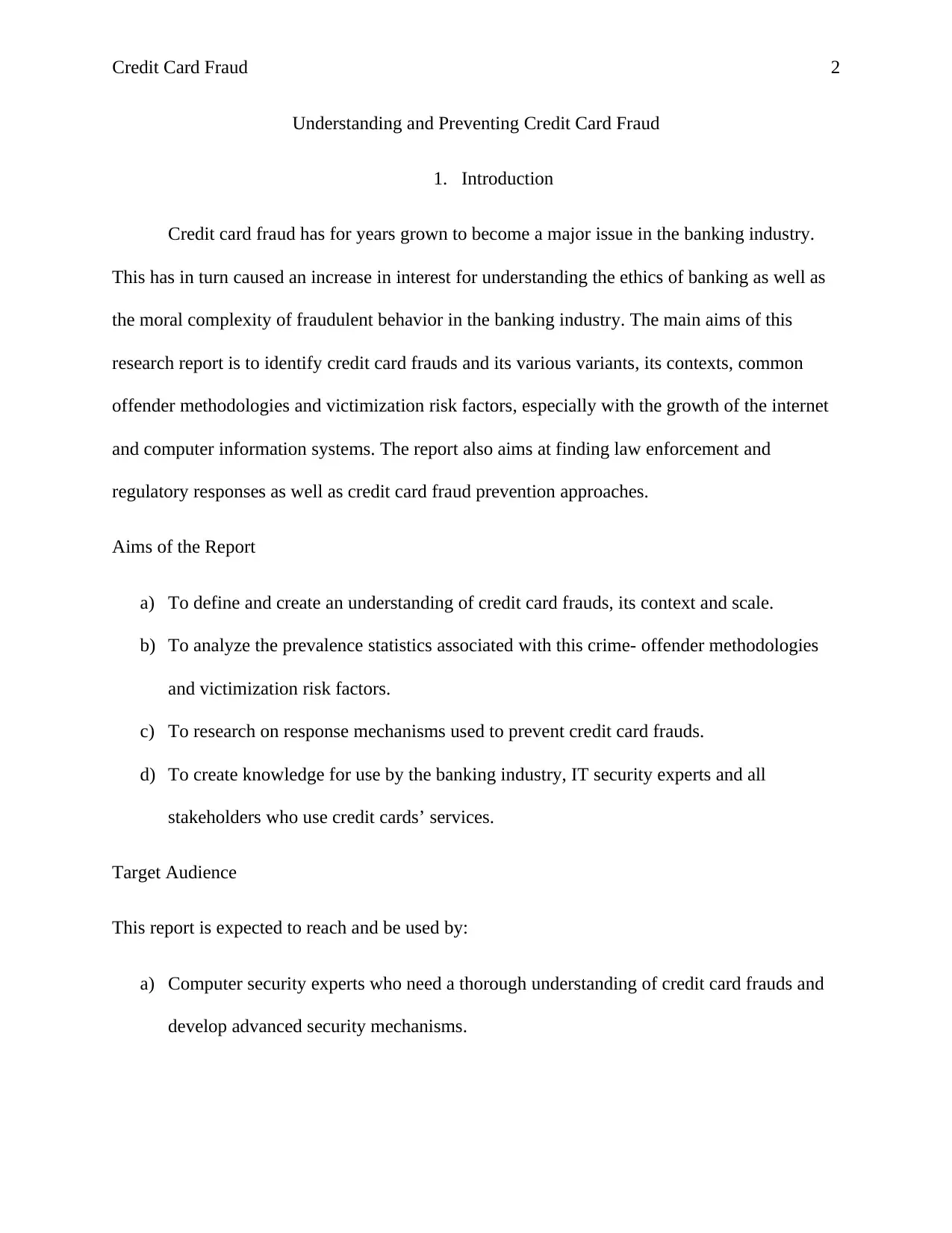
Credit Card Fraud 2
Understanding and Preventing Credit Card Fraud
1. Introduction
Credit card fraud has for years grown to become a major issue in the banking industry.
This has in turn caused an increase in interest for understanding the ethics of banking as well as
the moral complexity of fraudulent behavior in the banking industry. The main aims of this
research report is to identify credit card frauds and its various variants, its contexts, common
offender methodologies and victimization risk factors, especially with the growth of the internet
and computer information systems. The report also aims at finding law enforcement and
regulatory responses as well as credit card fraud prevention approaches.
Aims of the Report
a) To define and create an understanding of credit card frauds, its context and scale.
b) To analyze the prevalence statistics associated with this crime- offender methodologies
and victimization risk factors.
c) To research on response mechanisms used to prevent credit card frauds.
d) To create knowledge for use by the banking industry, IT security experts and all
stakeholders who use credit cards’ services.
Target Audience
This report is expected to reach and be used by:
a) Computer security experts who need a thorough understanding of credit card frauds and
develop advanced security mechanisms.
Understanding and Preventing Credit Card Fraud
1. Introduction
Credit card fraud has for years grown to become a major issue in the banking industry.
This has in turn caused an increase in interest for understanding the ethics of banking as well as
the moral complexity of fraudulent behavior in the banking industry. The main aims of this
research report is to identify credit card frauds and its various variants, its contexts, common
offender methodologies and victimization risk factors, especially with the growth of the internet
and computer information systems. The report also aims at finding law enforcement and
regulatory responses as well as credit card fraud prevention approaches.
Aims of the Report
a) To define and create an understanding of credit card frauds, its context and scale.
b) To analyze the prevalence statistics associated with this crime- offender methodologies
and victimization risk factors.
c) To research on response mechanisms used to prevent credit card frauds.
d) To create knowledge for use by the banking industry, IT security experts and all
stakeholders who use credit cards’ services.
Target Audience
This report is expected to reach and be used by:
a) Computer security experts who need a thorough understanding of credit card frauds and
develop advanced security mechanisms.
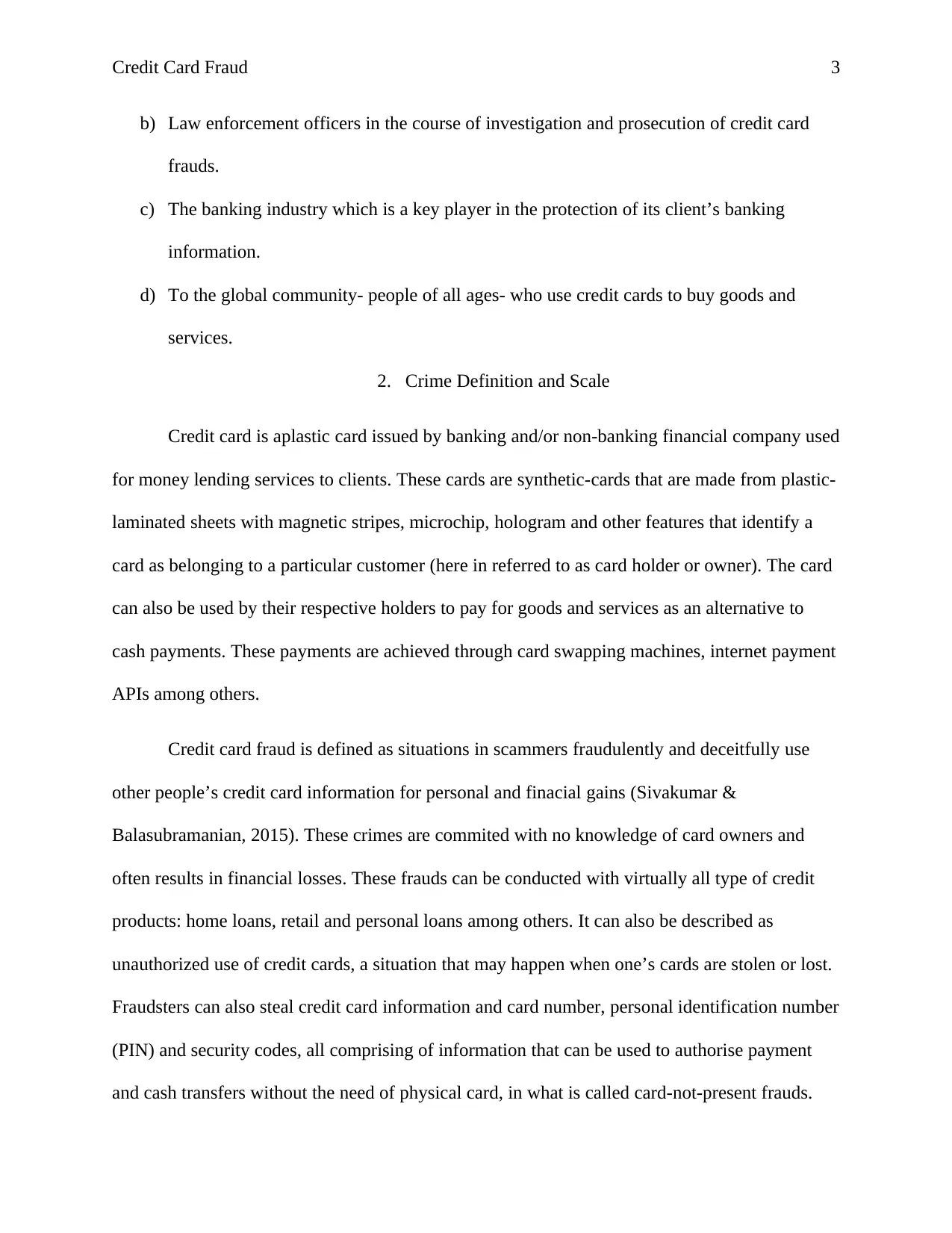
Credit Card Fraud 3
b) Law enforcement officers in the course of investigation and prosecution of credit card
frauds.
c) The banking industry which is a key player in the protection of its client’s banking
information.
d) To the global community- people of all ages- who use credit cards to buy goods and
services.
2. Crime Definition and Scale
Credit card is aplastic card issued by banking and/or non-banking financial company used
for money lending services to clients. These cards are synthetic-cards that are made from plastic-
laminated sheets with magnetic stripes, microchip, hologram and other features that identify a
card as belonging to a particular customer (here in referred to as card holder or owner). The card
can also be used by their respective holders to pay for goods and services as an alternative to
cash payments. These payments are achieved through card swapping machines, internet payment
APIs among others.
Credit card fraud is defined as situations in scammers fraudulently and deceitfully use
other people’s credit card information for personal and finacial gains (Sivakumar &
Balasubramanian, 2015). These crimes are commited with no knowledge of card owners and
often results in financial losses. These frauds can be conducted with virtually all type of credit
products: home loans, retail and personal loans among others. It can also be described as
unauthorized use of credit cards, a situation that may happen when one’s cards are stolen or lost.
Fraudsters can also steal credit card information and card number, personal identification number
(PIN) and security codes, all comprising of information that can be used to authorise payment
and cash transfers without the need of physical card, in what is called card-not-present frauds.
b) Law enforcement officers in the course of investigation and prosecution of credit card
frauds.
c) The banking industry which is a key player in the protection of its client’s banking
information.
d) To the global community- people of all ages- who use credit cards to buy goods and
services.
2. Crime Definition and Scale
Credit card is aplastic card issued by banking and/or non-banking financial company used
for money lending services to clients. These cards are synthetic-cards that are made from plastic-
laminated sheets with magnetic stripes, microchip, hologram and other features that identify a
card as belonging to a particular customer (here in referred to as card holder or owner). The card
can also be used by their respective holders to pay for goods and services as an alternative to
cash payments. These payments are achieved through card swapping machines, internet payment
APIs among others.
Credit card fraud is defined as situations in scammers fraudulently and deceitfully use
other people’s credit card information for personal and finacial gains (Sivakumar &
Balasubramanian, 2015). These crimes are commited with no knowledge of card owners and
often results in financial losses. These frauds can be conducted with virtually all type of credit
products: home loans, retail and personal loans among others. It can also be described as
unauthorized use of credit cards, a situation that may happen when one’s cards are stolen or lost.
Fraudsters can also steal credit card information and card number, personal identification number
(PIN) and security codes, all comprising of information that can be used to authorise payment
and cash transfers without the need of physical card, in what is called card-not-present frauds.
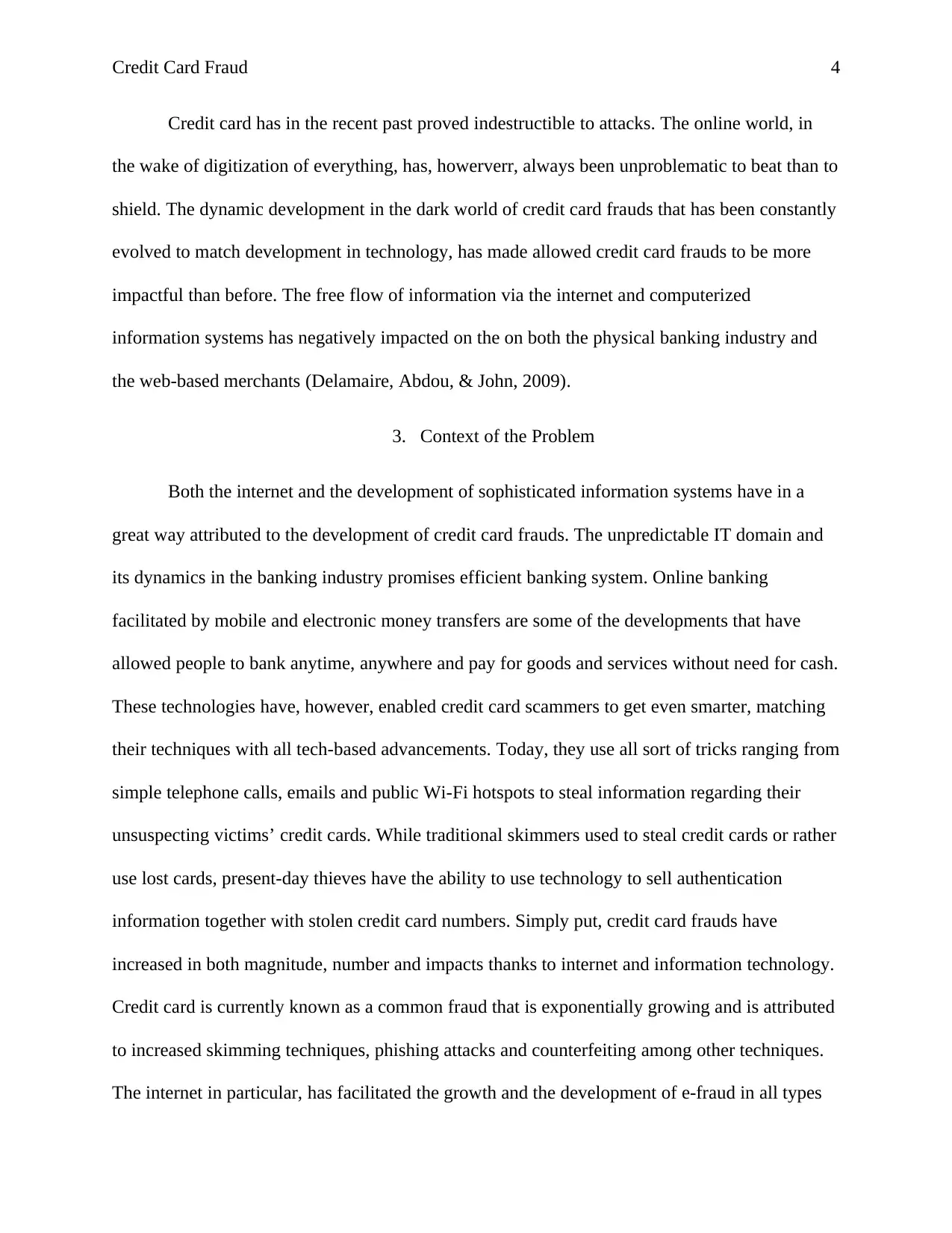
Credit Card Fraud 4
Credit card has in the recent past proved indestructible to attacks. The online world, in
the wake of digitization of everything, has, howerverr, always been unproblematic to beat than to
shield. The dynamic development in the dark world of credit card frauds that has been constantly
evolved to match development in technology, has made allowed credit card frauds to be more
impactful than before. The free flow of information via the internet and computerized
information systems has negatively impacted on the on both the physical banking industry and
the web-based merchants (Delamaire, Abdou, & John, 2009).
3. Context of the Problem
Both the internet and the development of sophisticated information systems have in a
great way attributed to the development of credit card frauds. The unpredictable IT domain and
its dynamics in the banking industry promises efficient banking system. Online banking
facilitated by mobile and electronic money transfers are some of the developments that have
allowed people to bank anytime, anywhere and pay for goods and services without need for cash.
These technologies have, however, enabled credit card scammers to get even smarter, matching
their techniques with all tech-based advancements. Today, they use all sort of tricks ranging from
simple telephone calls, emails and public Wi-Fi hotspots to steal information regarding their
unsuspecting victims’ credit cards. While traditional skimmers used to steal credit cards or rather
use lost cards, present-day thieves have the ability to use technology to sell authentication
information together with stolen credit card numbers. Simply put, credit card frauds have
increased in both magnitude, number and impacts thanks to internet and information technology.
Credit card is currently known as a common fraud that is exponentially growing and is attributed
to increased skimming techniques, phishing attacks and counterfeiting among other techniques.
The internet in particular, has facilitated the growth and the development of e-fraud in all types
Credit card has in the recent past proved indestructible to attacks. The online world, in
the wake of digitization of everything, has, howerverr, always been unproblematic to beat than to
shield. The dynamic development in the dark world of credit card frauds that has been constantly
evolved to match development in technology, has made allowed credit card frauds to be more
impactful than before. The free flow of information via the internet and computerized
information systems has negatively impacted on the on both the physical banking industry and
the web-based merchants (Delamaire, Abdou, & John, 2009).
3. Context of the Problem
Both the internet and the development of sophisticated information systems have in a
great way attributed to the development of credit card frauds. The unpredictable IT domain and
its dynamics in the banking industry promises efficient banking system. Online banking
facilitated by mobile and electronic money transfers are some of the developments that have
allowed people to bank anytime, anywhere and pay for goods and services without need for cash.
These technologies have, however, enabled credit card scammers to get even smarter, matching
their techniques with all tech-based advancements. Today, they use all sort of tricks ranging from
simple telephone calls, emails and public Wi-Fi hotspots to steal information regarding their
unsuspecting victims’ credit cards. While traditional skimmers used to steal credit cards or rather
use lost cards, present-day thieves have the ability to use technology to sell authentication
information together with stolen credit card numbers. Simply put, credit card frauds have
increased in both magnitude, number and impacts thanks to internet and information technology.
Credit card is currently known as a common fraud that is exponentially growing and is attributed
to increased skimming techniques, phishing attacks and counterfeiting among other techniques.
The internet in particular, has facilitated the growth and the development of e-fraud in all types
Secure Best Marks with AI Grader
Need help grading? Try our AI Grader for instant feedback on your assignments.
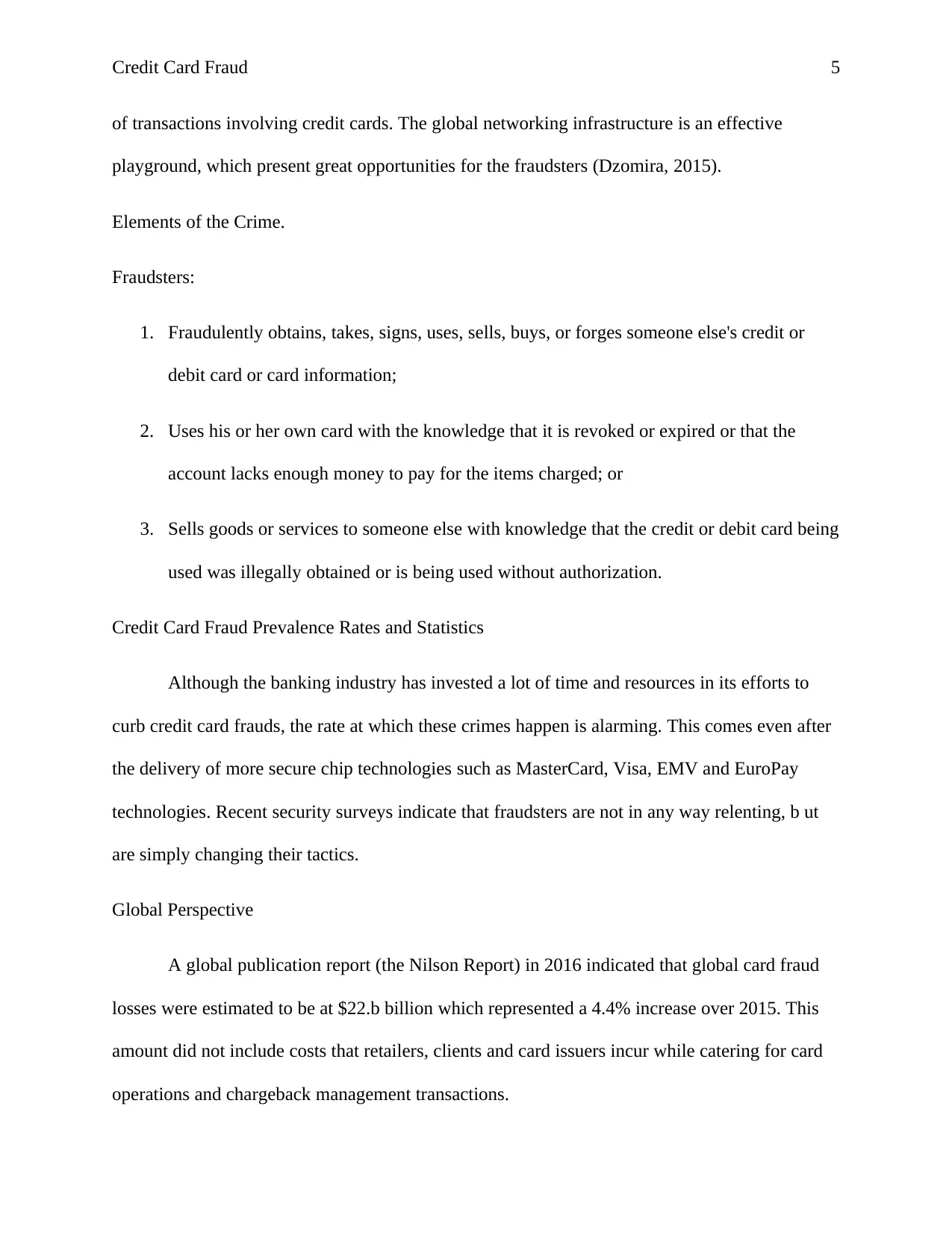
Credit Card Fraud 5
of transactions involving credit cards. The global networking infrastructure is an effective
playground, which present great opportunities for the fraudsters (Dzomira, 2015).
Elements of the Crime.
Fraudsters:
1. Fraudulently obtains, takes, signs, uses, sells, buys, or forges someone else's credit or
debit card or card information;
2. Uses his or her own card with the knowledge that it is revoked or expired or that the
account lacks enough money to pay for the items charged; or
3. Sells goods or services to someone else with knowledge that the credit or debit card being
used was illegally obtained or is being used without authorization.
Credit Card Fraud Prevalence Rates and Statistics
Although the banking industry has invested a lot of time and resources in its efforts to
curb credit card frauds, the rate at which these crimes happen is alarming. This comes even after
the delivery of more secure chip technologies such as MasterCard, Visa, EMV and EuroPay
technologies. Recent security surveys indicate that fraudsters are not in any way relenting, b ut
are simply changing their tactics.
Global Perspective
A global publication report (the Nilson Report) in 2016 indicated that global card fraud
losses were estimated to be at $22.b billion which represented a 4.4% increase over 2015. This
amount did not include costs that retailers, clients and card issuers incur while catering for card
operations and chargeback management transactions.
of transactions involving credit cards. The global networking infrastructure is an effective
playground, which present great opportunities for the fraudsters (Dzomira, 2015).
Elements of the Crime.
Fraudsters:
1. Fraudulently obtains, takes, signs, uses, sells, buys, or forges someone else's credit or
debit card or card information;
2. Uses his or her own card with the knowledge that it is revoked or expired or that the
account lacks enough money to pay for the items charged; or
3. Sells goods or services to someone else with knowledge that the credit or debit card being
used was illegally obtained or is being used without authorization.
Credit Card Fraud Prevalence Rates and Statistics
Although the banking industry has invested a lot of time and resources in its efforts to
curb credit card frauds, the rate at which these crimes happen is alarming. This comes even after
the delivery of more secure chip technologies such as MasterCard, Visa, EMV and EuroPay
technologies. Recent security surveys indicate that fraudsters are not in any way relenting, b ut
are simply changing their tactics.
Global Perspective
A global publication report (the Nilson Report) in 2016 indicated that global card fraud
losses were estimated to be at $22.b billion which represented a 4.4% increase over 2015. This
amount did not include costs that retailers, clients and card issuers incur while catering for card
operations and chargeback management transactions.
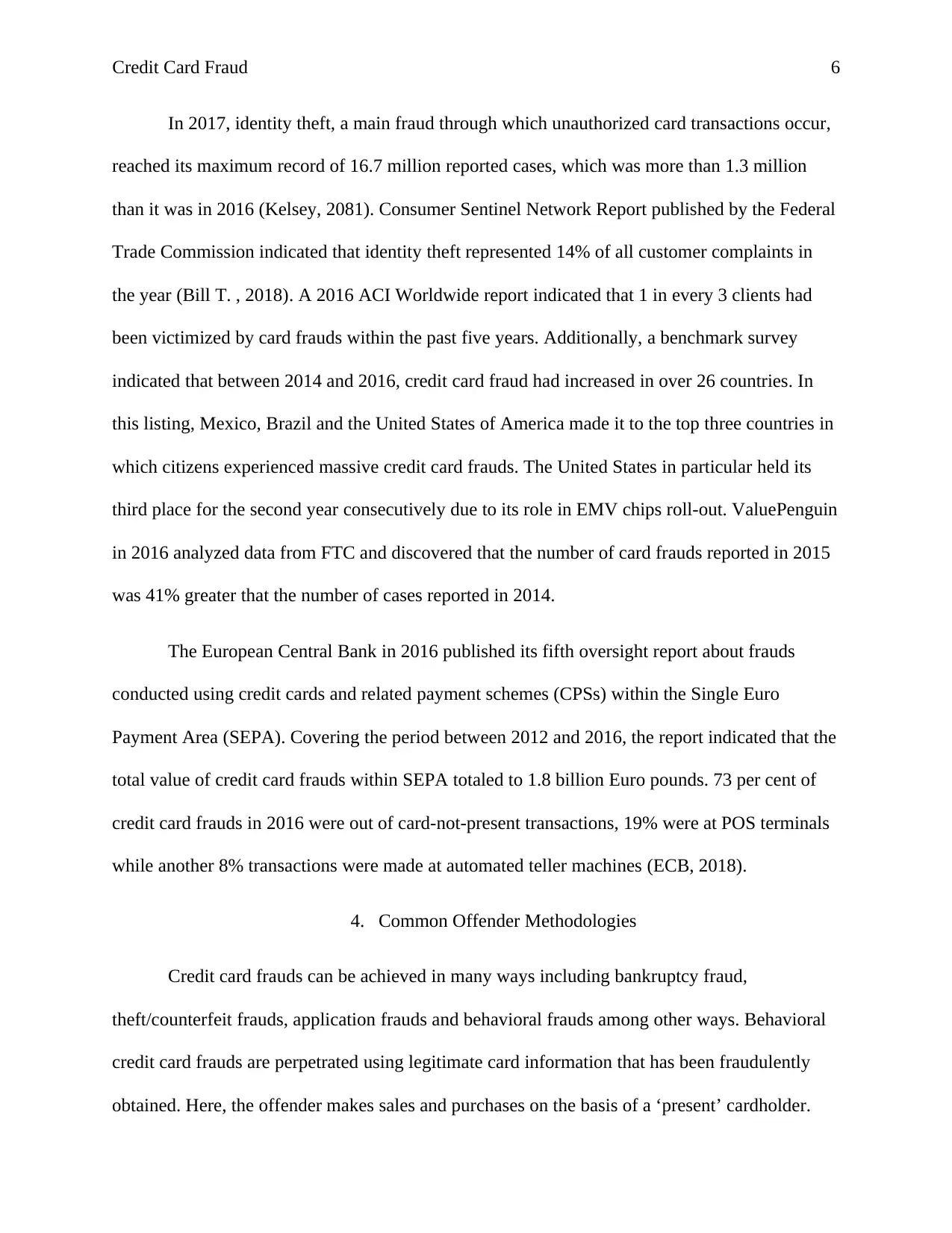
Credit Card Fraud 6
In 2017, identity theft, a main fraud through which unauthorized card transactions occur,
reached its maximum record of 16.7 million reported cases, which was more than 1.3 million
than it was in 2016 (Kelsey, 2081). Consumer Sentinel Network Report published by the Federal
Trade Commission indicated that identity theft represented 14% of all customer complaints in
the year (Bill T. , 2018). A 2016 ACI Worldwide report indicated that 1 in every 3 clients had
been victimized by card frauds within the past five years. Additionally, a benchmark survey
indicated that between 2014 and 2016, credit card fraud had increased in over 26 countries. In
this listing, Mexico, Brazil and the United States of America made it to the top three countries in
which citizens experienced massive credit card frauds. The United States in particular held its
third place for the second year consecutively due to its role in EMV chips roll-out. ValuePenguin
in 2016 analyzed data from FTC and discovered that the number of card frauds reported in 2015
was 41% greater that the number of cases reported in 2014.
The European Central Bank in 2016 published its fifth oversight report about frauds
conducted using credit cards and related payment schemes (CPSs) within the Single Euro
Payment Area (SEPA). Covering the period between 2012 and 2016, the report indicated that the
total value of credit card frauds within SEPA totaled to 1.8 billion Euro pounds. 73 per cent of
credit card frauds in 2016 were out of card-not-present transactions, 19% were at POS terminals
while another 8% transactions were made at automated teller machines (ECB, 2018).
4. Common Offender Methodologies
Credit card frauds can be achieved in many ways including bankruptcy fraud,
theft/counterfeit frauds, application frauds and behavioral frauds among other ways. Behavioral
credit card frauds are perpetrated using legitimate card information that has been fraudulently
obtained. Here, the offender makes sales and purchases on the basis of a ‘present’ cardholder.
In 2017, identity theft, a main fraud through which unauthorized card transactions occur,
reached its maximum record of 16.7 million reported cases, which was more than 1.3 million
than it was in 2016 (Kelsey, 2081). Consumer Sentinel Network Report published by the Federal
Trade Commission indicated that identity theft represented 14% of all customer complaints in
the year (Bill T. , 2018). A 2016 ACI Worldwide report indicated that 1 in every 3 clients had
been victimized by card frauds within the past five years. Additionally, a benchmark survey
indicated that between 2014 and 2016, credit card fraud had increased in over 26 countries. In
this listing, Mexico, Brazil and the United States of America made it to the top three countries in
which citizens experienced massive credit card frauds. The United States in particular held its
third place for the second year consecutively due to its role in EMV chips roll-out. ValuePenguin
in 2016 analyzed data from FTC and discovered that the number of card frauds reported in 2015
was 41% greater that the number of cases reported in 2014.
The European Central Bank in 2016 published its fifth oversight report about frauds
conducted using credit cards and related payment schemes (CPSs) within the Single Euro
Payment Area (SEPA). Covering the period between 2012 and 2016, the report indicated that the
total value of credit card frauds within SEPA totaled to 1.8 billion Euro pounds. 73 per cent of
credit card frauds in 2016 were out of card-not-present transactions, 19% were at POS terminals
while another 8% transactions were made at automated teller machines (ECB, 2018).
4. Common Offender Methodologies
Credit card frauds can be achieved in many ways including bankruptcy fraud,
theft/counterfeit frauds, application frauds and behavioral frauds among other ways. Behavioral
credit card frauds are perpetrated using legitimate card information that has been fraudulently
obtained. Here, the offender makes sales and purchases on the basis of a ‘present’ cardholder.
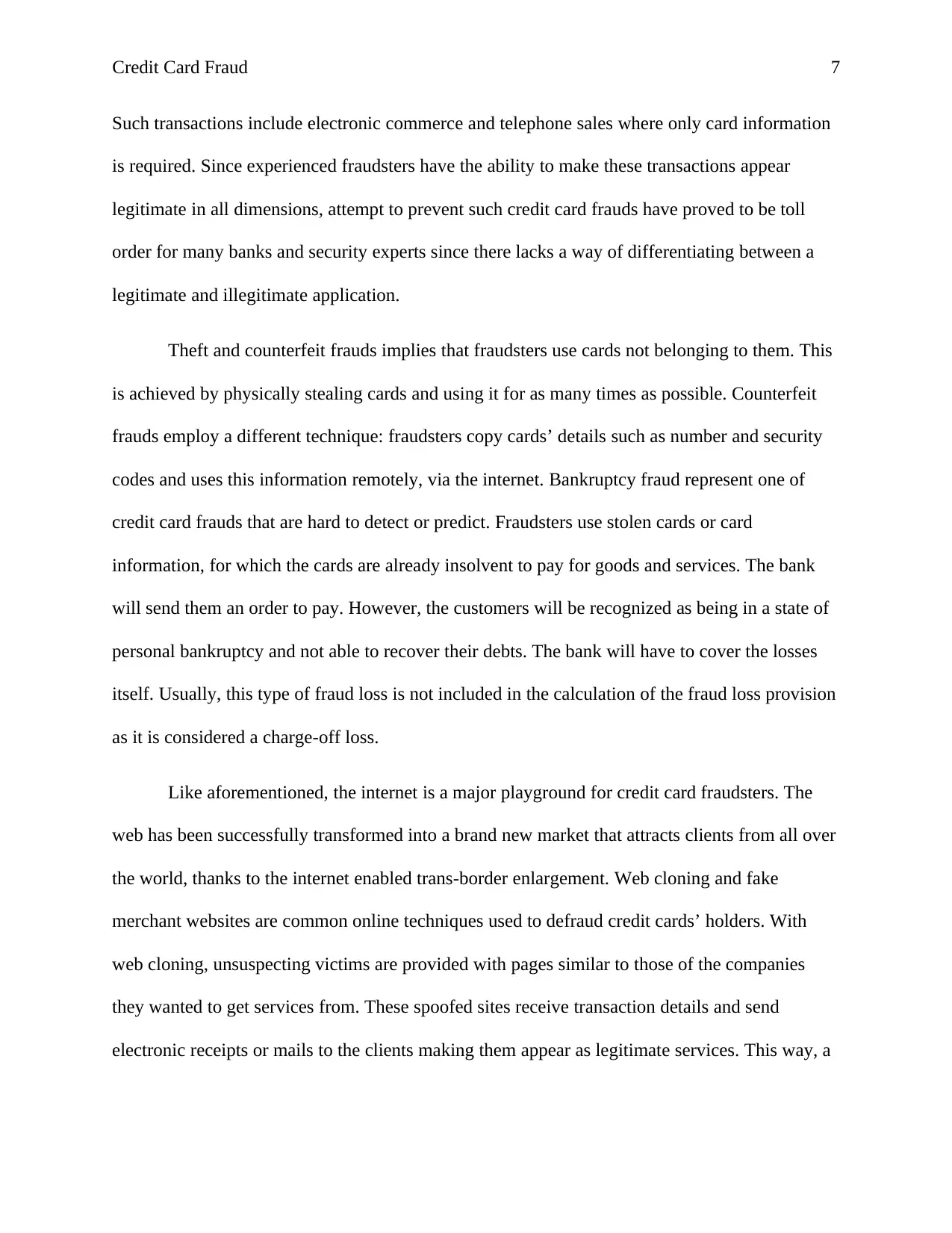
Credit Card Fraud 7
Such transactions include electronic commerce and telephone sales where only card information
is required. Since experienced fraudsters have the ability to make these transactions appear
legitimate in all dimensions, attempt to prevent such credit card frauds have proved to be toll
order for many banks and security experts since there lacks a way of differentiating between a
legitimate and illegitimate application.
Theft and counterfeit frauds implies that fraudsters use cards not belonging to them. This
is achieved by physically stealing cards and using it for as many times as possible. Counterfeit
frauds employ a different technique: fraudsters copy cards’ details such as number and security
codes and uses this information remotely, via the internet. Bankruptcy fraud represent one of
credit card frauds that are hard to detect or predict. Fraudsters use stolen cards or card
information, for which the cards are already insolvent to pay for goods and services. The bank
will send them an order to pay. However, the customers will be recognized as being in a state of
personal bankruptcy and not able to recover their debts. The bank will have to cover the losses
itself. Usually, this type of fraud loss is not included in the calculation of the fraud loss provision
as it is considered a charge-off loss.
Like aforementioned, the internet is a major playground for credit card fraudsters. The
web has been successfully transformed into a brand new market that attracts clients from all over
the world, thanks to the internet enabled trans-border enlargement. Web cloning and fake
merchant websites are common online techniques used to defraud credit cards’ holders. With
web cloning, unsuspecting victims are provided with pages similar to those of the companies
they wanted to get services from. These spoofed sites receive transaction details and send
electronic receipts or mails to the clients making them appear as legitimate services. This way, a
Such transactions include electronic commerce and telephone sales where only card information
is required. Since experienced fraudsters have the ability to make these transactions appear
legitimate in all dimensions, attempt to prevent such credit card frauds have proved to be toll
order for many banks and security experts since there lacks a way of differentiating between a
legitimate and illegitimate application.
Theft and counterfeit frauds implies that fraudsters use cards not belonging to them. This
is achieved by physically stealing cards and using it for as many times as possible. Counterfeit
frauds employ a different technique: fraudsters copy cards’ details such as number and security
codes and uses this information remotely, via the internet. Bankruptcy fraud represent one of
credit card frauds that are hard to detect or predict. Fraudsters use stolen cards or card
information, for which the cards are already insolvent to pay for goods and services. The bank
will send them an order to pay. However, the customers will be recognized as being in a state of
personal bankruptcy and not able to recover their debts. The bank will have to cover the losses
itself. Usually, this type of fraud loss is not included in the calculation of the fraud loss provision
as it is considered a charge-off loss.
Like aforementioned, the internet is a major playground for credit card fraudsters. The
web has been successfully transformed into a brand new market that attracts clients from all over
the world, thanks to the internet enabled trans-border enlargement. Web cloning and fake
merchant websites are common online techniques used to defraud credit cards’ holders. With
web cloning, unsuspecting victims are provided with pages similar to those of the companies
they wanted to get services from. These spoofed sites receive transaction details and send
electronic receipts or mails to the clients making them appear as legitimate services. This way, a
Paraphrase This Document
Need a fresh take? Get an instant paraphrase of this document with our AI Paraphraser
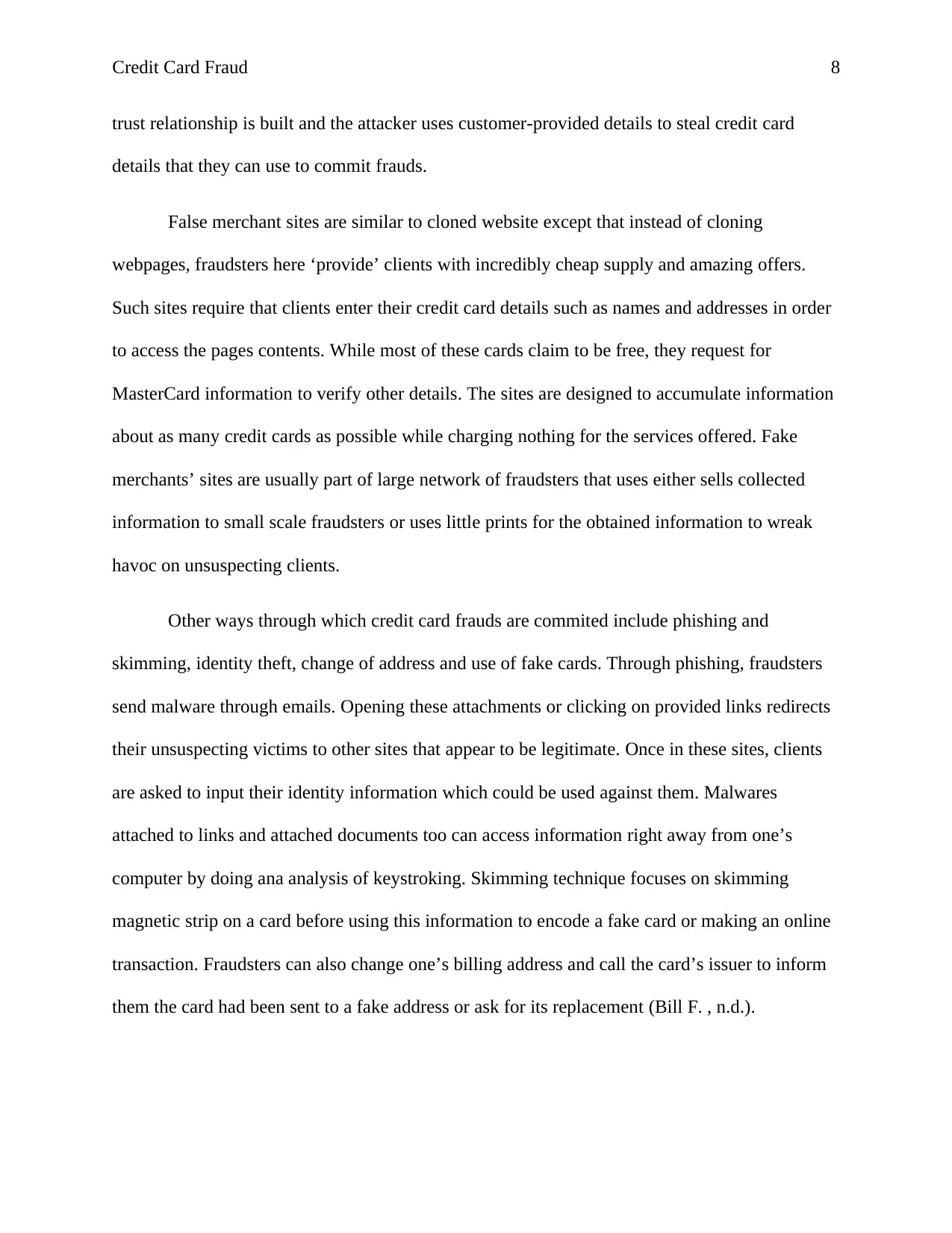
Credit Card Fraud 8
trust relationship is built and the attacker uses customer-provided details to steal credit card
details that they can use to commit frauds.
False merchant sites are similar to cloned website except that instead of cloning
webpages, fraudsters here ‘provide’ clients with incredibly cheap supply and amazing offers.
Such sites require that clients enter their credit card details such as names and addresses in order
to access the pages contents. While most of these cards claim to be free, they request for
MasterCard information to verify other details. The sites are designed to accumulate information
about as many credit cards as possible while charging nothing for the services offered. Fake
merchants’ sites are usually part of large network of fraudsters that uses either sells collected
information to small scale fraudsters or uses little prints for the obtained information to wreak
havoc on unsuspecting clients.
Other ways through which credit card frauds are commited include phishing and
skimming, identity theft, change of address and use of fake cards. Through phishing, fraudsters
send malware through emails. Opening these attachments or clicking on provided links redirects
their unsuspecting victims to other sites that appear to be legitimate. Once in these sites, clients
are asked to input their identity information which could be used against them. Malwares
attached to links and attached documents too can access information right away from one’s
computer by doing ana analysis of keystroking. Skimming technique focuses on skimming
magnetic strip on a card before using this information to encode a fake card or making an online
transaction. Fraudsters can also change one’s billing address and call the card’s issuer to inform
them the card had been sent to a fake address or ask for its replacement (Bill F. , n.d.).
trust relationship is built and the attacker uses customer-provided details to steal credit card
details that they can use to commit frauds.
False merchant sites are similar to cloned website except that instead of cloning
webpages, fraudsters here ‘provide’ clients with incredibly cheap supply and amazing offers.
Such sites require that clients enter their credit card details such as names and addresses in order
to access the pages contents. While most of these cards claim to be free, they request for
MasterCard information to verify other details. The sites are designed to accumulate information
about as many credit cards as possible while charging nothing for the services offered. Fake
merchants’ sites are usually part of large network of fraudsters that uses either sells collected
information to small scale fraudsters or uses little prints for the obtained information to wreak
havoc on unsuspecting clients.
Other ways through which credit card frauds are commited include phishing and
skimming, identity theft, change of address and use of fake cards. Through phishing, fraudsters
send malware through emails. Opening these attachments or clicking on provided links redirects
their unsuspecting victims to other sites that appear to be legitimate. Once in these sites, clients
are asked to input their identity information which could be used against them. Malwares
attached to links and attached documents too can access information right away from one’s
computer by doing ana analysis of keystroking. Skimming technique focuses on skimming
magnetic strip on a card before using this information to encode a fake card or making an online
transaction. Fraudsters can also change one’s billing address and call the card’s issuer to inform
them the card had been sent to a fake address or ask for its replacement (Bill F. , n.d.).
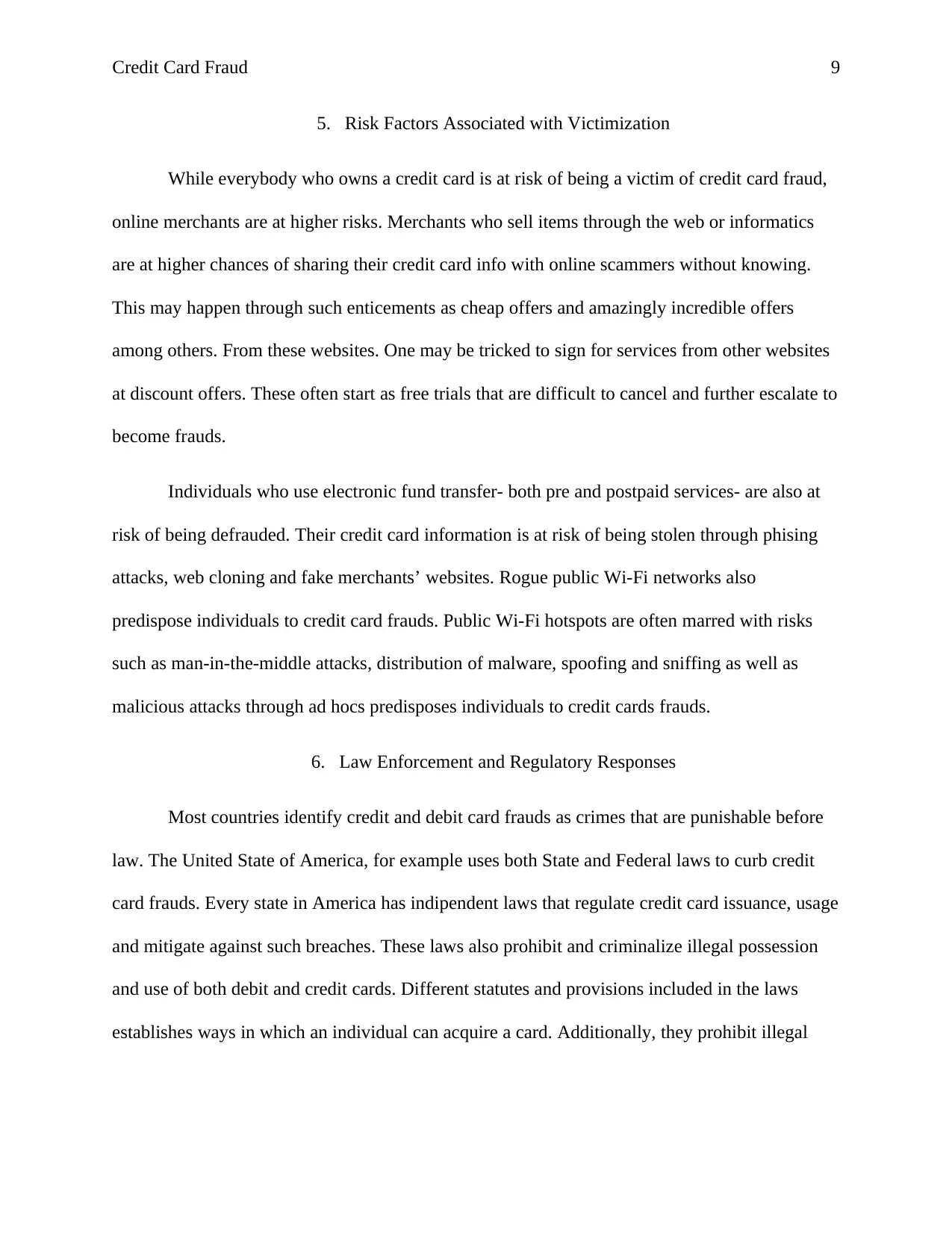
Credit Card Fraud 9
5. Risk Factors Associated with Victimization
While everybody who owns a credit card is at risk of being a victim of credit card fraud,
online merchants are at higher risks. Merchants who sell items through the web or informatics
are at higher chances of sharing their credit card info with online scammers without knowing.
This may happen through such enticements as cheap offers and amazingly incredible offers
among others. From these websites. One may be tricked to sign for services from other websites
at discount offers. These often start as free trials that are difficult to cancel and further escalate to
become frauds.
Individuals who use electronic fund transfer- both pre and postpaid services- are also at
risk of being defrauded. Their credit card information is at risk of being stolen through phising
attacks, web cloning and fake merchants’ websites. Rogue public Wi-Fi networks also
predispose individuals to credit card frauds. Public Wi-Fi hotspots are often marred with risks
such as man-in-the-middle attacks, distribution of malware, spoofing and sniffing as well as
malicious attacks through ad hocs predisposes individuals to credit cards frauds.
6. Law Enforcement and Regulatory Responses
Most countries identify credit and debit card frauds as crimes that are punishable before
law. The United State of America, for example uses both State and Federal laws to curb credit
card frauds. Every state in America has indipendent laws that regulate credit card issuance, usage
and mitigate against such breaches. These laws also prohibit and criminalize illegal possession
and use of both debit and credit cards. Different statutes and provisions included in the laws
establishes ways in which an individual can acquire a card. Additionally, they prohibit illegal
5. Risk Factors Associated with Victimization
While everybody who owns a credit card is at risk of being a victim of credit card fraud,
online merchants are at higher risks. Merchants who sell items through the web or informatics
are at higher chances of sharing their credit card info with online scammers without knowing.
This may happen through such enticements as cheap offers and amazingly incredible offers
among others. From these websites. One may be tricked to sign for services from other websites
at discount offers. These often start as free trials that are difficult to cancel and further escalate to
become frauds.
Individuals who use electronic fund transfer- both pre and postpaid services- are also at
risk of being defrauded. Their credit card information is at risk of being stolen through phising
attacks, web cloning and fake merchants’ websites. Rogue public Wi-Fi networks also
predispose individuals to credit card frauds. Public Wi-Fi hotspots are often marred with risks
such as man-in-the-middle attacks, distribution of malware, spoofing and sniffing as well as
malicious attacks through ad hocs predisposes individuals to credit cards frauds.
6. Law Enforcement and Regulatory Responses
Most countries identify credit and debit card frauds as crimes that are punishable before
law. The United State of America, for example uses both State and Federal laws to curb credit
card frauds. Every state in America has indipendent laws that regulate credit card issuance, usage
and mitigate against such breaches. These laws also prohibit and criminalize illegal possession
and use of both debit and credit cards. Different statutes and provisions included in the laws
establishes ways in which an individual can acquire a card. Additionally, they prohibit illegal
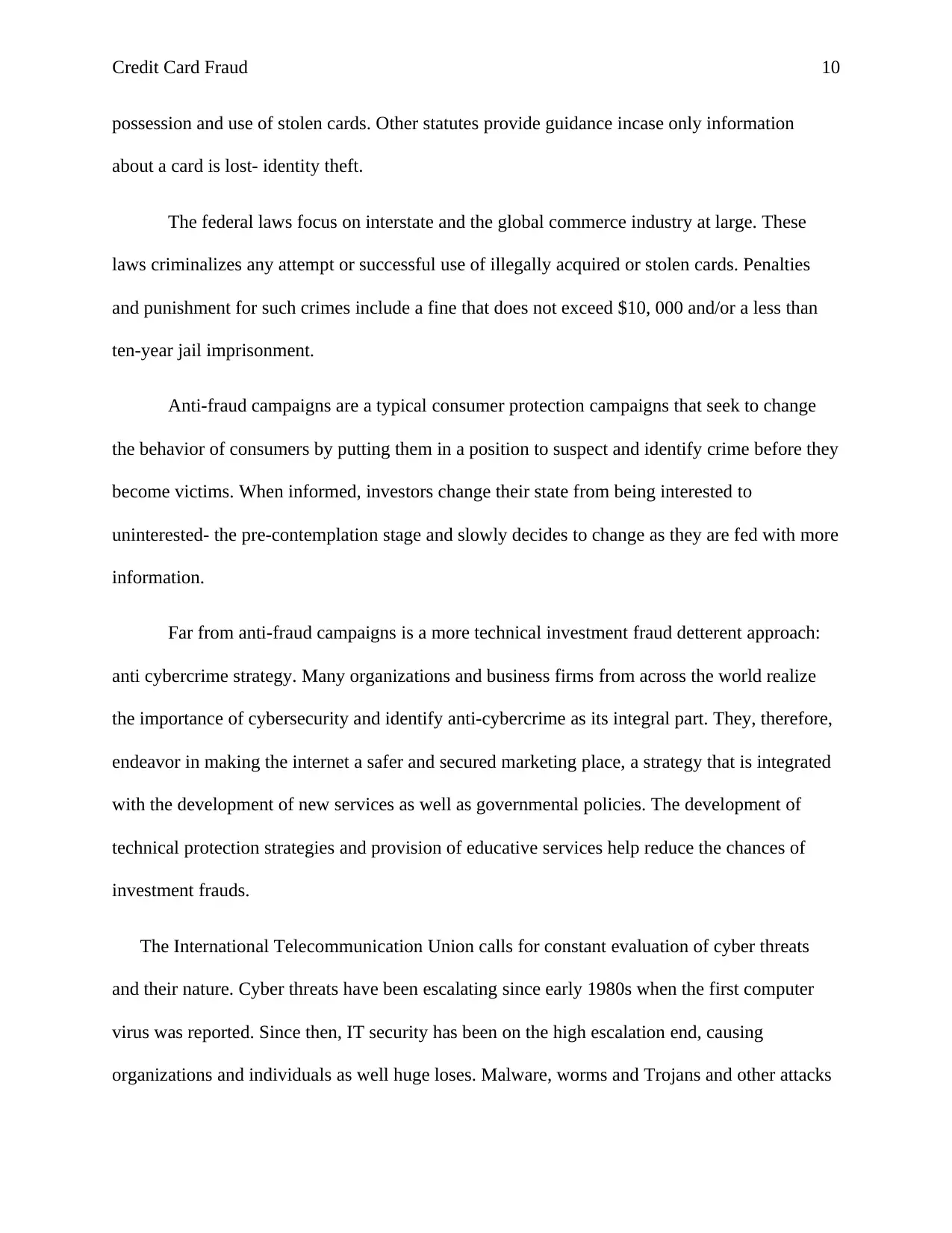
Credit Card Fraud 10
possession and use of stolen cards. Other statutes provide guidance incase only information
about a card is lost- identity theft.
The federal laws focus on interstate and the global commerce industry at large. These
laws criminalizes any attempt or successful use of illegally acquired or stolen cards. Penalties
and punishment for such crimes include a fine that does not exceed $10, 000 and/or a less than
ten-year jail imprisonment.
Anti-fraud campaigns are a typical consumer protection campaigns that seek to change
the behavior of consumers by putting them in a position to suspect and identify crime before they
become victims. When informed, investors change their state from being interested to
uninterested- the pre-contemplation stage and slowly decides to change as they are fed with more
information.
Far from anti-fraud campaigns is a more technical investment fraud detterent approach:
anti cybercrime strategy. Many organizations and business firms from across the world realize
the importance of cybersecurity and identify anti-cybercrime as its integral part. They, therefore,
endeavor in making the internet a safer and secured marketing place, a strategy that is integrated
with the development of new services as well as governmental policies. The development of
technical protection strategies and provision of educative services help reduce the chances of
investment frauds.
The International Telecommunication Union calls for constant evaluation of cyber threats
and their nature. Cyber threats have been escalating since early 1980s when the first computer
virus was reported. Since then, IT security has been on the high escalation end, causing
organizations and individuals as well huge loses. Malware, worms and Trojans and other attacks
possession and use of stolen cards. Other statutes provide guidance incase only information
about a card is lost- identity theft.
The federal laws focus on interstate and the global commerce industry at large. These
laws criminalizes any attempt or successful use of illegally acquired or stolen cards. Penalties
and punishment for such crimes include a fine that does not exceed $10, 000 and/or a less than
ten-year jail imprisonment.
Anti-fraud campaigns are a typical consumer protection campaigns that seek to change
the behavior of consumers by putting them in a position to suspect and identify crime before they
become victims. When informed, investors change their state from being interested to
uninterested- the pre-contemplation stage and slowly decides to change as they are fed with more
information.
Far from anti-fraud campaigns is a more technical investment fraud detterent approach:
anti cybercrime strategy. Many organizations and business firms from across the world realize
the importance of cybersecurity and identify anti-cybercrime as its integral part. They, therefore,
endeavor in making the internet a safer and secured marketing place, a strategy that is integrated
with the development of new services as well as governmental policies. The development of
technical protection strategies and provision of educative services help reduce the chances of
investment frauds.
The International Telecommunication Union calls for constant evaluation of cyber threats
and their nature. Cyber threats have been escalating since early 1980s when the first computer
virus was reported. Since then, IT security has been on the high escalation end, causing
organizations and individuals as well huge loses. Malware, worms and Trojans and other attacks
Secure Best Marks with AI Grader
Need help grading? Try our AI Grader for instant feedback on your assignments.
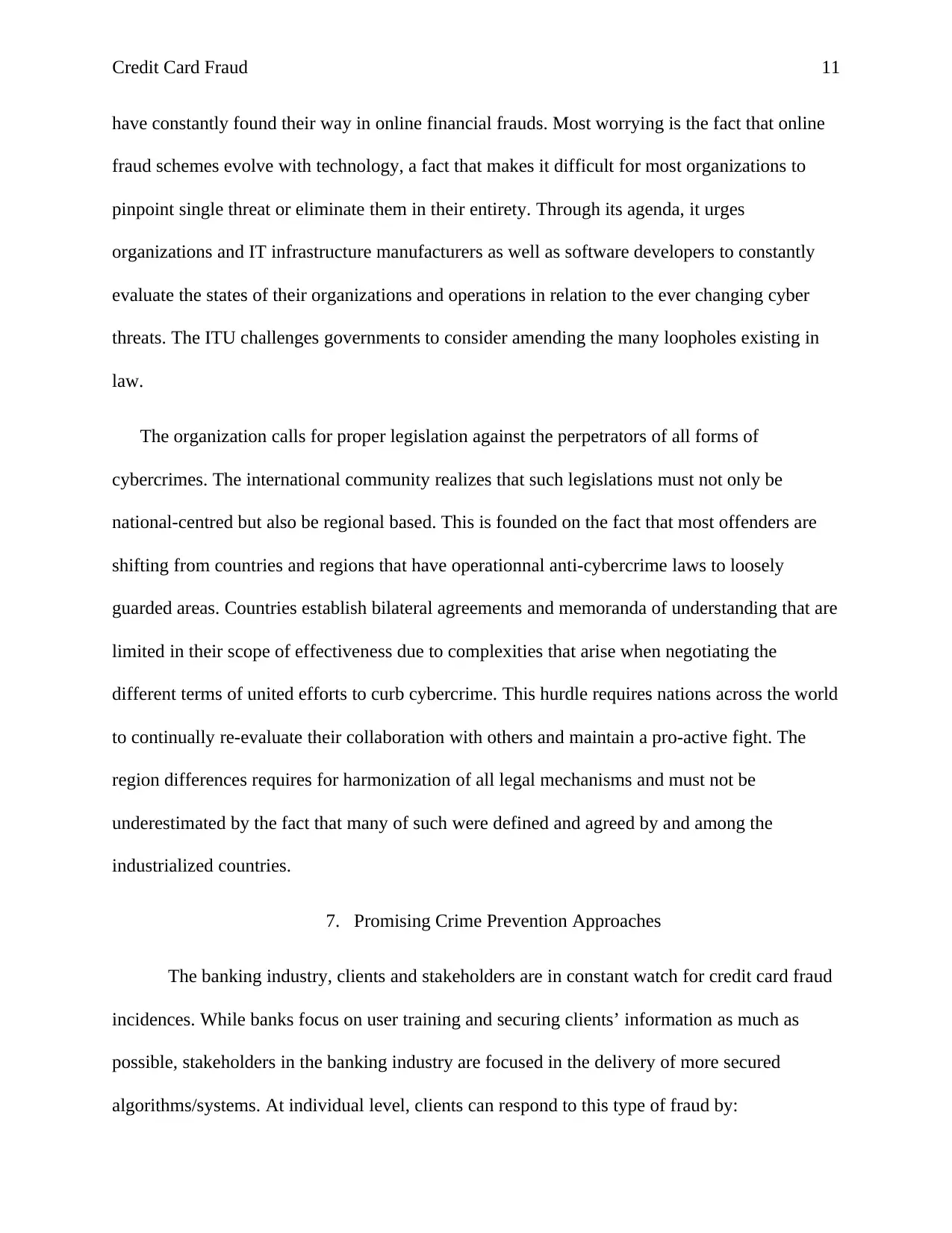
Credit Card Fraud 11
have constantly found their way in online financial frauds. Most worrying is the fact that online
fraud schemes evolve with technology, a fact that makes it difficult for most organizations to
pinpoint single threat or eliminate them in their entirety. Through its agenda, it urges
organizations and IT infrastructure manufacturers as well as software developers to constantly
evaluate the states of their organizations and operations in relation to the ever changing cyber
threats. The ITU challenges governments to consider amending the many loopholes existing in
law.
The organization calls for proper legislation against the perpetrators of all forms of
cybercrimes. The international community realizes that such legislations must not only be
national-centred but also be regional based. This is founded on the fact that most offenders are
shifting from countries and regions that have operationnal anti-cybercrime laws to loosely
guarded areas. Countries establish bilateral agreements and memoranda of understanding that are
limited in their scope of effectiveness due to complexities that arise when negotiating the
different terms of united efforts to curb cybercrime. This hurdle requires nations across the world
to continually re-evaluate their collaboration with others and maintain a pro-active fight. The
region differences requires for harmonization of all legal mechanisms and must not be
underestimated by the fact that many of such were defined and agreed by and among the
industrialized countries.
7. Promising Crime Prevention Approaches
The banking industry, clients and stakeholders are in constant watch for credit card fraud
incidences. While banks focus on user training and securing clients’ information as much as
possible, stakeholders in the banking industry are focused in the delivery of more secured
algorithms/systems. At individual level, clients can respond to this type of fraud by:
have constantly found their way in online financial frauds. Most worrying is the fact that online
fraud schemes evolve with technology, a fact that makes it difficult for most organizations to
pinpoint single threat or eliminate them in their entirety. Through its agenda, it urges
organizations and IT infrastructure manufacturers as well as software developers to constantly
evaluate the states of their organizations and operations in relation to the ever changing cyber
threats. The ITU challenges governments to consider amending the many loopholes existing in
law.
The organization calls for proper legislation against the perpetrators of all forms of
cybercrimes. The international community realizes that such legislations must not only be
national-centred but also be regional based. This is founded on the fact that most offenders are
shifting from countries and regions that have operationnal anti-cybercrime laws to loosely
guarded areas. Countries establish bilateral agreements and memoranda of understanding that are
limited in their scope of effectiveness due to complexities that arise when negotiating the
different terms of united efforts to curb cybercrime. This hurdle requires nations across the world
to continually re-evaluate their collaboration with others and maintain a pro-active fight. The
region differences requires for harmonization of all legal mechanisms and must not be
underestimated by the fact that many of such were defined and agreed by and among the
industrialized countries.
7. Promising Crime Prevention Approaches
The banking industry, clients and stakeholders are in constant watch for credit card fraud
incidences. While banks focus on user training and securing clients’ information as much as
possible, stakeholders in the banking industry are focused in the delivery of more secured
algorithms/systems. At individual level, clients can respond to this type of fraud by:
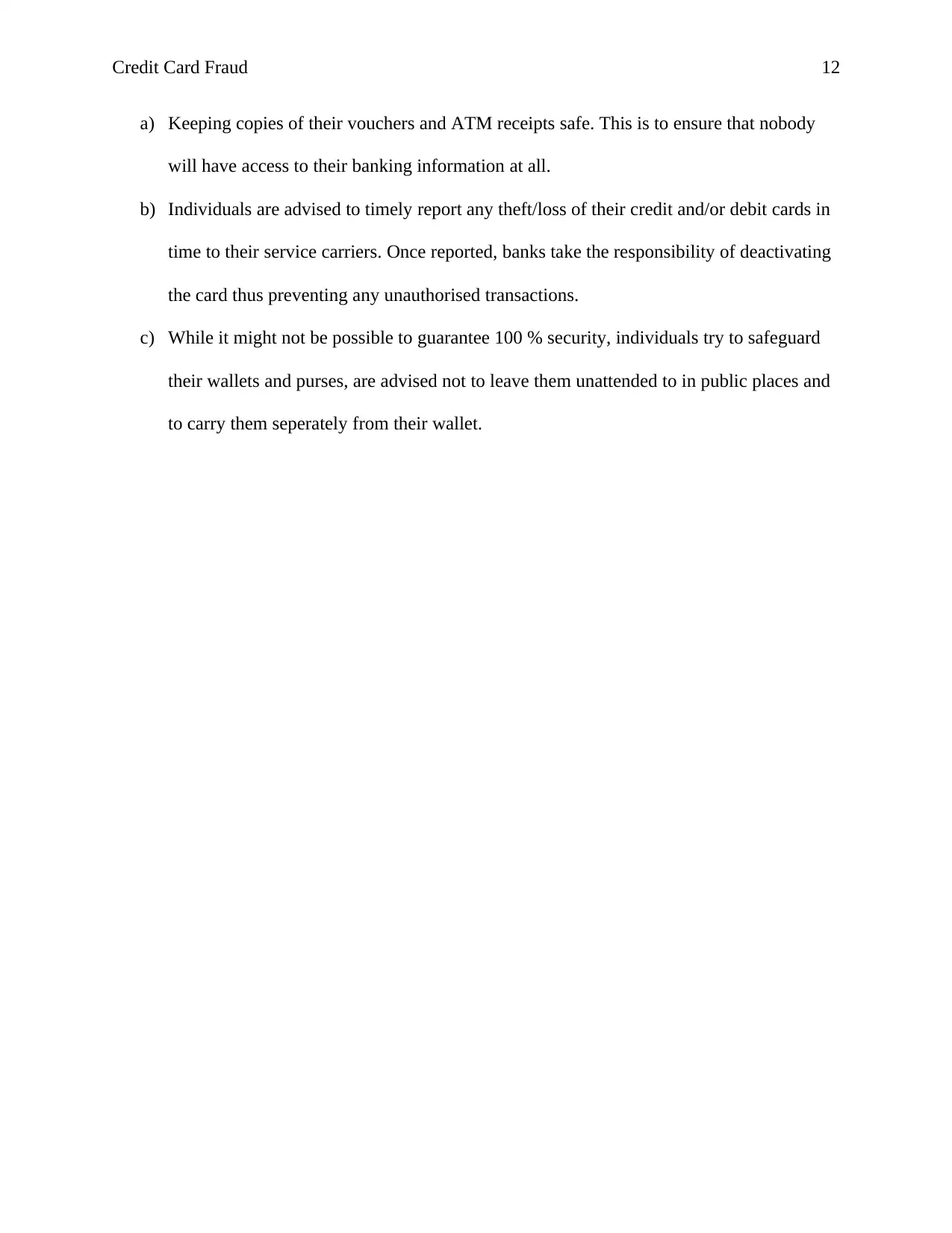
Credit Card Fraud 12
a) Keeping copies of their vouchers and ATM receipts safe. This is to ensure that nobody
will have access to their banking information at all.
b) Individuals are advised to timely report any theft/loss of their credit and/or debit cards in
time to their service carriers. Once reported, banks take the responsibility of deactivating
the card thus preventing any unauthorised transactions.
c) While it might not be possible to guarantee 100 % security, individuals try to safeguard
their wallets and purses, are advised not to leave them unattended to in public places and
to carry them seperately from their wallet.
a) Keeping copies of their vouchers and ATM receipts safe. This is to ensure that nobody
will have access to their banking information at all.
b) Individuals are advised to timely report any theft/loss of their credit and/or debit cards in
time to their service carriers. Once reported, banks take the responsibility of deactivating
the card thus preventing any unauthorised transactions.
c) While it might not be possible to guarantee 100 % security, individuals try to safeguard
their wallets and purses, are advised not to leave them unattended to in public places and
to carry them seperately from their wallet.
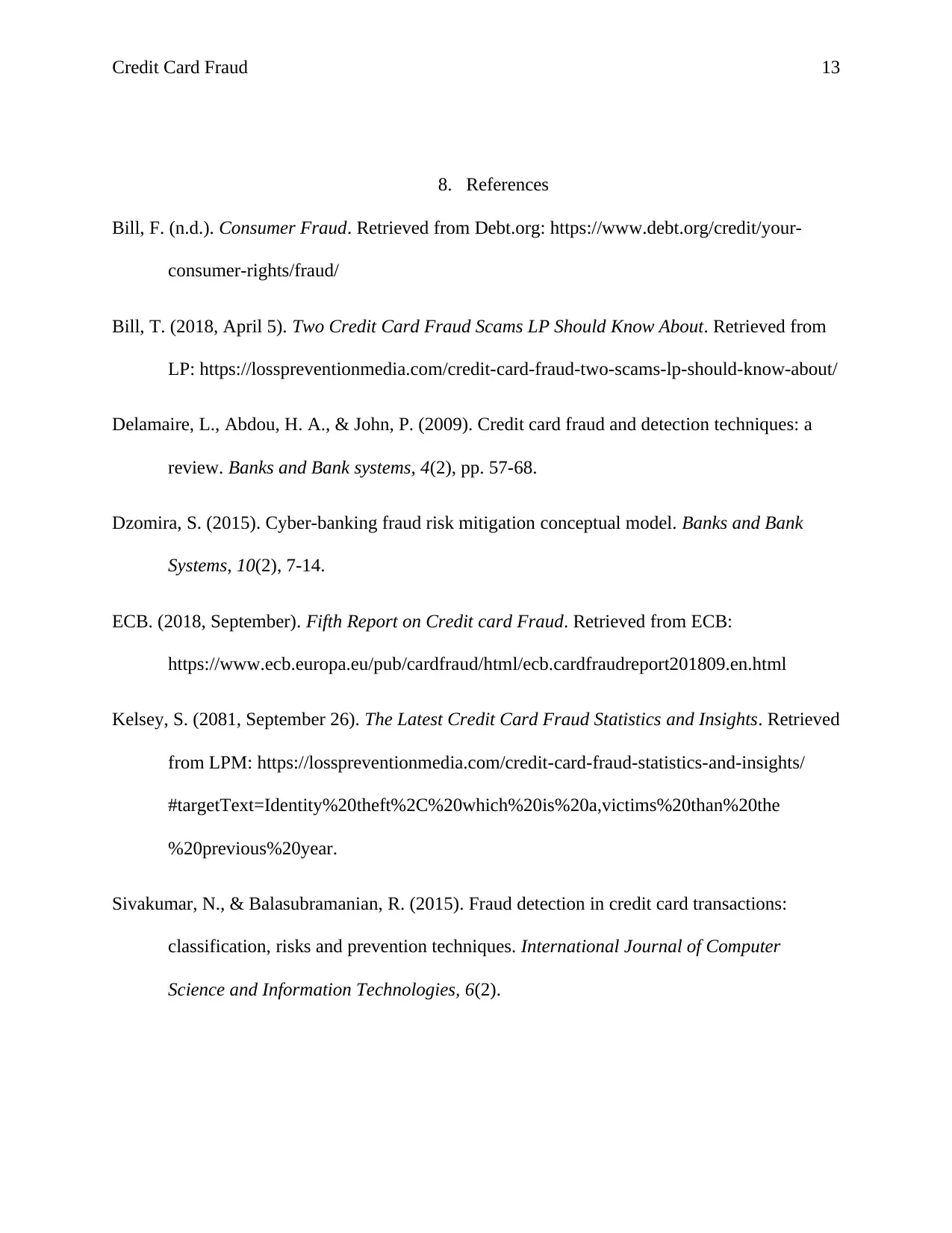
Credit Card Fraud 13
8. References
Bill, F. (n.d.). Consumer Fraud. Retrieved from Debt.org: https://www.debt.org/credit/your-
consumer-rights/fraud/
Bill, T. (2018, April 5). Two Credit Card Fraud Scams LP Should Know About. Retrieved from
LP: https://losspreventionmedia.com/credit-card-fraud-two-scams-lp-should-know-about/
Delamaire, L., Abdou, H. A., & John, P. (2009). Credit card fraud and detection techniques: a
review. Banks and Bank systems, 4(2), pp. 57-68.
Dzomira, S. (2015). Cyber-banking fraud risk mitigation conceptual model. Banks and Bank
Systems, 10(2), 7-14.
ECB. (2018, September). Fifth Report on Credit card Fraud. Retrieved from ECB:
https://www.ecb.europa.eu/pub/cardfraud/html/ecb.cardfraudreport201809.en.html
Kelsey, S. (2081, September 26). The Latest Credit Card Fraud Statistics and Insights. Retrieved
from LPM: https://losspreventionmedia.com/credit-card-fraud-statistics-and-insights/
#targetText=Identity%20theft%2C%20which%20is%20a,victims%20than%20the
%20previous%20year.
Sivakumar, N., & Balasubramanian, R. (2015). Fraud detection in credit card transactions:
classification, risks and prevention techniques. International Journal of Computer
Science and Information Technologies, 6(2).
8. References
Bill, F. (n.d.). Consumer Fraud. Retrieved from Debt.org: https://www.debt.org/credit/your-
consumer-rights/fraud/
Bill, T. (2018, April 5). Two Credit Card Fraud Scams LP Should Know About. Retrieved from
LP: https://losspreventionmedia.com/credit-card-fraud-two-scams-lp-should-know-about/
Delamaire, L., Abdou, H. A., & John, P. (2009). Credit card fraud and detection techniques: a
review. Banks and Bank systems, 4(2), pp. 57-68.
Dzomira, S. (2015). Cyber-banking fraud risk mitigation conceptual model. Banks and Bank
Systems, 10(2), 7-14.
ECB. (2018, September). Fifth Report on Credit card Fraud. Retrieved from ECB:
https://www.ecb.europa.eu/pub/cardfraud/html/ecb.cardfraudreport201809.en.html
Kelsey, S. (2081, September 26). The Latest Credit Card Fraud Statistics and Insights. Retrieved
from LPM: https://losspreventionmedia.com/credit-card-fraud-statistics-and-insights/
#targetText=Identity%20theft%2C%20which%20is%20a,victims%20than%20the
%20previous%20year.
Sivakumar, N., & Balasubramanian, R. (2015). Fraud detection in credit card transactions:
classification, risks and prevention techniques. International Journal of Computer
Science and Information Technologies, 6(2).
1 out of 13
Related Documents
Your All-in-One AI-Powered Toolkit for Academic Success.
+13062052269
info@desklib.com
Available 24*7 on WhatsApp / Email
![[object Object]](/_next/static/media/star-bottom.7253800d.svg)
Unlock your academic potential
© 2024 | Zucol Services PVT LTD | All rights reserved.





